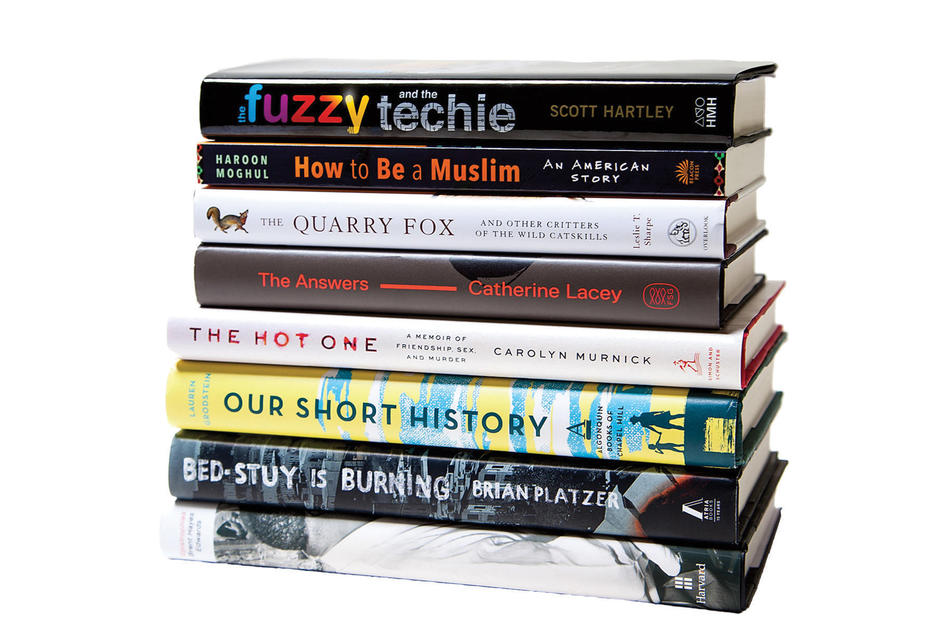Bed-Stuy is Burning
by Brian Platzer ’04CC
The Brooklyn neighborhood of Bedford-Stuyvesant doesn’t look the same as it did in Spike Lee’s 1989 film Do the Right Thing, to which the title of this debut novel alludes. But tensions around race and police brutality are still potent. Here, after a Ferguson-like episode, riots break out, with a white family at the center of the chaos.
The Hot One
by Carolyn Murnick ’01GS
When Carolyn Murnick was twenty-two years old, her childhood best friend, Ashley Ellerin, was found murdered in her Los Angeles home. Tabloids picked up the story when it came to light that Ashley had been casually dating actor Ashton Kutcher. In this riveting memoir, Murnick — now an editor at New York magazine — delves deeply into her friend’s secret life, trying to get to the truth about her murder.
The Quarry Fox
by Leslie T. Sharpe ’73GSAS
Not everyone is lucky enough to live on top of a mountain, overlooking a meadow full of wildflowers. But reading naturalist Leslie T. Sharpe’s reflection on life in the western Catskills might be the next best thing. Her snapshots of local wilderness — from a luna moth on the screen door to a bear and her cubs settling into hibernation — are vivid and soothing.
Epistrophies
by Brent Hayes Edwards ’98GSAS
Jazz and literature have long intersected, with composers and writers each seeking inspiration from the other. See, for example, Thelonious Monk’s song “Epistrophy” — whose title refers to a literary device of rhythmic repetition; Amiri Baraka later wrote a poem in homage to the song. In this erudite text, Columbia literature professor Brent Hayes Edwards uses jazz writings — from record liner notes to letters from Louis Armstrong — to analyze the relationship between the two art forms.
How to Be a Muslim
by Haroon Moghul ’10GSAS
Haroon Moghul was an undergraduate at NYU when 9/11 made him an unlikely public figure. As the student leader of the university’s Islamic center, he was frequently asked to give interviews and speeches and ended up becoming a sort of spokesman for young American Muslims. But Moghul was also struggling with his own beliefs, and with mental-health issues. Now a PhD candidate in Middle Eastern, South Asian, and African Studies at Columbia, he writes movingly about his search for an identity that felt comfortable.
The Answers
by Catherine Lacey ’10SOA
Mary — the heroine of Catherine Lacey’s new novel — is drowning in debt and desperate for a second job when she answers a Craigslist ad for “The Girlfriend Experiment,” engineered by a rich and famous actor. Soon she finds herself part of a strange harem, where different women are cast in different girlfriend roles — Mary is the Emotional Girlfriend, but there is also the Maternal Girlfriend, the Anger Girlfriend, and several Intimacy Girlfriends — to create one ideal composite. The result, like an episode of Black Mirror, is intriguing and deeply unsettling.
The Fuzzy and the Techie
by Scott Hartley ’11BUS, ’11SIPA
In our tech-focused world, it’s easy to imagine that in the future, liberal-arts degrees will be obsolete and only engineers and robots will have jobs. Not so, says venture capitalist Scott Hartley (also an alum of Google and Facebook), who argues that data is meaningless without creative humans — particularly ones well versed in the arts and humanities — behind it.
Our Short History
by Lauren Grodstein ’97CC, ’01SOA
For six years, political consultant Karen has parented her son Jacob alone. Now she’s terminally ill, and time is running out for her to introduce Jacob to his father, a former client and fling who never had any interest in children. Lauren Grodstein’s new novel is epistolary — it’s a long letter from Karen to Jacob — a format that could feel maudlin, were it not for her protagonist’s wit and charming self-deprecation.



